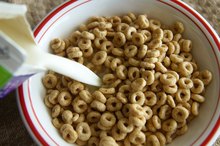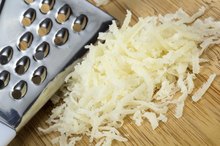Does a Milk Allergy Rash in Infants Look Different Than Other Rashes?
According to the Food Allergy and Anaphylaxis Network, milk is one of the most common allergens for children under age three. Most infants who are allergic to milk exhibit symptoms early, during their first year, and many outgrow it. A milk allergy is different from lactose intolerance; allergies involve a reaction of the infant's immune system, while intolerance involves the digestive system. A rash is one possible indication that your infant is allergic to milk.
Types of Milk Allergy Rashes
Many different types of rashes could indicate that your infant is allergic to milk. Any allergic reaction to food can give your infant a rash. Some of the common type of rashes caused by milk allergies are acne, hives and eczema, all of which can appear on any part of your infant's body. Rashes caused by a milk allergy may also be concentrated around your baby's mouth. A milk allergy can also create a red ring rash around your infant's anus, often accompanied by a diaper rash.
- Many different types of rashes could indicate that your infant is allergic to milk.
- Some of the common type of rashes caused by milk allergies are acne, hives and eczema, all of which can appear on any part of your infant's body.
Distinguishing Milk Rash from Others
Milk Allergy & Skin Rash
Learn More
A milk allergy rash usually appears shortly after your infant is exposed to milk, often within a few hours. If your infant is having an allergic reaction, he will often have other symptoms such as:
- diarrhea
- vomiting
- runny nose
- irritability
- difficulty breathing
- swelling
If your baby is breastfed and allergic to cow dairy in breast milk, he will probably have a reaction within 2 to to 24 hours after the mother is exposed to dairy.
Treatment
The best way to treat a milk allergy rash is to eliminate the infant's exposure to dairy. You can do this with an elimination diet, in which you remove all sources of dairy from the baby's diet. Remove dairy from your infant's diet for at least two to three weeks, and watch to see if symptoms improve. If you are breastfeeding and suspect that the rash is caused by cow protein in your breastmilk, it may take as long as four weeks for all the dairy to get out of your infant's system and for symptoms to completely disappear.
- The best way to treat a milk allergy rash is to eliminate the infant's exposure to dairy.
- If you are breastfeeding and suspect that the rash is caused by cow protein in your breastmilk, it may take as long as four weeks for all the dairy to get out of your infant's system and for symptoms to completely disappear.
Other Common Rashes in Infants
Dairy & Puffy Eyes
Learn More
If eliminating all dairy from your infant's diet does not clear up his rash, then consider other causes for your baby's rash. Other common types of rash in infants include contact rash, yeast rash and impetigo. If your baby's rash seems to be an allergic reaction but eliminating milk does not cause it to improve, then consider other possible food allergies as the cause 1.
Related Articles
References
- Wholesome Baby Food: Baby Food and Allergies
- Ask Dr. Sears; Diaper Rash; Dr. William Sears
- Caffarelli C, Baldi F, Bendandi B, et al. Cow's milk protein allergy in children: a practical guide. Ital J Pediatr. 2010;36:5. doi:10.1186/1824-7288-36-5
- Vieira MC, Morais MB, Spolidoro JV, et al. A survey on clinical presentation and nutritional status of infants with suspected cow' milk allergy. BMC Pediatr. 2010;10:25. doi:10.1186/1471-2431-10-25
- Anvari S, Miller J, Yeh CY, Davis CM. IgE-Mediated Food Allergy. Clin Rev Allergy Immunol. 2018; doi:10.1007/s12016-018-8710-3
- Leonard SA, Pecora V, Fiocchi AG, Nowak-wegrzyn A. Food protein-induced enterocolitis syndrome: a review of the new guidelines. World Allergy Organ J. 2018;11(1):4. doi:10.1186/s40413-017-0182-z
- Flom JD, Sicherer SH. Epidemiology of Cow's Milk Allergy. Nutrients. 2019;11(5) doi:10.3390/nu11051051
- Anagnostou K. Safety of Oral Food Challenges in Early Life. Children (Basel). 2018;5(6) doi:10.3390/children5060065
- Ferraro V, Zanconato S, Carraro S. Timing of Food Introduction and the Risk of Food Allergy. Nutrients. 2019;11(5) doi:10.3390/nu11051131
- Kelly E, DunnGalvin G, Murphy BP, Hourihane JO. Formula supplementation remains a risk for cow's milk allergy in breast-fed infants.Pediatr Allergy Immunol. 2019 Jul 11. doi: 10.1111/pai.13108. [Epub ahead of print]
- Nocerino R, Di Costanzo M, Bedogni G, Cosenza L, Maddalena Y, Di Scala C, et al. Dietary Treatment with Extensively Hydrolyzed Casein Formula Containing the Probiotic Lactobacillus rhamnosus GG Prevents the Occurrence of Functional Gastrointestinal Disorders in Children with Cow's Milk Allergy.J Pediatr. 2019 Jul 18. pii: S0022-3476(19)30698-5. doi: 10.1016/j.jpeds.2019.06.004. [Epub ahead of print]
Writer Bio
Lisa Baker has been a professional writer since 2001. She has published articles on parenting, environmental issues and religious topics in a variety of print and online venues, including "HomeLife Magazine" and "Pink & Green." She holds a Bachelor of Arts in English from Sweet Briar College.









